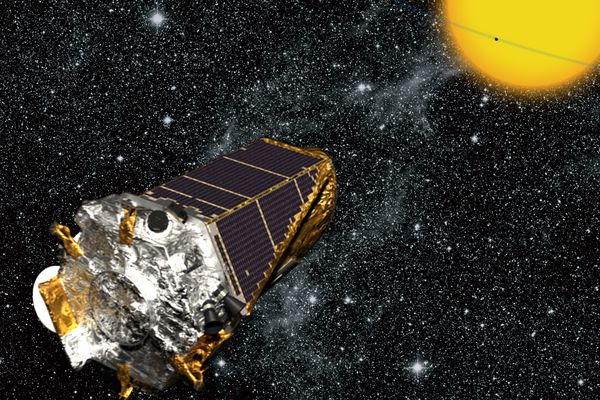
On Oct. 30, NASA finally retired the Kepler space telescope, the prolific planet-hunter that has been scanning the skies for the past nine years. If you’ve been following the mission over the last several months, you might recall that the spacecraft was put to sleep and brought back into service a few times as it was slowly running out of fuel. What you may not realize is that much of this drama was unfolding locally, from a control room at the Laboratory for Atmospheric and Space Physics (LASP) on the east campus of the University of Colorado.
The Kepler spacecraft was built in Boulder by Ball Aerospace, and launched from Cape Canaveral in March 2009. Its original four-year mission was designed to learn how common planets like the Earth are around other stars in our galaxy. To accomplish this goal, the telescope stared at a patch of the summer Milky Way about the size of your fist at arms length. With few interruptions over four years, it carefully measured the brightness of 200,000 stars every 30 minutes, waiting for the shadow of a planet to pass.
The idea behind this galactic census was simple. Some fraction of the carefully selected target stars would have planets. If the planets were randomly oriented in space, then a few percent would pass directly in front of their star from Kepler’s vantage point. The amount of light that went missing for several hours during these mini-eclipses would reveal the size of the planet compared to the star. The interval between eclipses was the orbital period of the planet, shorter for those that are close to their star and longer for those farther away.
The results of Kepler’s survey are astounding. It revealed that nearly every star in the sky probably has at least one orbiting world, and the most common planets in the galaxy are two or three times larger than the Earth. In the 20 years prior to Kepler, astronomers had discovered about 400 planets around other stars. During its lifetime, Kepler found 2,700 confirmed planets and identified another 2,900 suspected worlds that are still waiting to be verified. Several hundred of these are at just the right distance from their star where liquid water could possibly exist.
“Kepler has captured the public imagination,” says Lee Reedy, Kepler Flight Director in Mission Operations at LASP. “It’s been really inspiring to see people, amateur astronomers and even kids, combing through the data and finding new and exciting things.”
Reedy moved to Boulder from Colorado Springs in 2012. He was working at LASP when the original Kepler mission ended in 2013, and has managed ground operations during the extended mission that just finished, known as K2. In 2013, a critical hardware failure left Kepler unable to continue pointing at its original targets. Engineers at Ball Aerospace devised a clever fix that allowed the telescope to continue searching for planets during shorter campaigns in other parts of the sky. The team at LASP was responsible for implementing the new strategy.
For the past five years, the K2 mission has pointed at a series of positions all around the sky, monitoring new targets for about 80 days at a time. The shorter duration meant that K2 could only find planets that were relatively close to their star, moving around quickly enough for K2 to see more than one eclipse in 80 days. But the flexibility of moving to new regions of the sky meant that K2 could do much more than just find planets, it could also do a broad range of interesting science.
The first indications that K2 was running out of fuel came in early July, so NASA placed the spacecraft in sleep mode until August. At that point they brought it back up, downloaded the data from the most recent observations, and pointed the telescope at the next set of targets. In late September, NASA put K2 back to sleep until mid-October when they downloaded the final set of data. Last week, when they tried to move to the next set of targets, the spacecraft finally ran out of fuel.
“Throughout all of it, we have used students to command Kepler and do engineering analysis on various subsystems,” Reedy mentions.
He explains that LASP hires students every year, and puts them through a summer training program where they learn about all of the missions that LASP is currently operating. Kepler was one of five or six. At the end of the summer, the students get certified to be command controllers. Using remote radio dishes in the Deep Space Network, which are large enough to cover a football stadium, they send commands to the spacecraft to download the data and point the telescope to the next position in the sky.
“I really feel like over the past few years I’ve grown up with Kepler in the aerospace department,” says Reidar Larsen, a student at CU who works as a command controller. “Everything that I have learned in class, I walk over to LASP and I see it in action.”
Like the rest of us, the students at LASP will undoubtedly miss the steady stream of observations coming from Kepler and K2. But even though they will no longer be collecting new data, these historic missions have gathered enough information over the past decade to keep astronomers busy for many years to come. The missions may be over, but the discoveries will certainly continue.
Travis Metcalfe, Ph.D., is a researcher and science communicator based in Boulder. The Lab Notes series is made possible in part by a research grant from the National Science Foundation.














